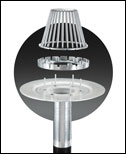Roofing in cold weather, such as during late fall and winter in northern climates, presents roofing contractors with challenges. In addition to having to manage relatively cold rooftop temperatures and increased moisture, contractors face working with roofing products that are temperature- and moisture-sensitive.
This year, NRCA established a Cold Weather Application Task Force to review manufacturers' recommendations for roofing product and roof system applications during cold weather.
Temperature limitations
Roofing contractors have long recognized certain roofing products and roof system types are temperature-sensitive. For example, with hot-applied bituminous roof systems, when ambient temperatures are less than 40 F, shortening the distances between bitumen heating equipment and the point of application and using insulated rooftop bitumen transport and dispensing equipment is recommended by NRCA and most manufacturers to make sure bitumen is at its equiviscous temperature at the point of application.
For self-sealing asphalt shingles, it is recognized shingles' sealing strips may not immediately activate if installed in cold weather. However, some manufacturers provide asphalt shingles with sealant strips that will activate at lower temperatures. Also, in some cold-weather application situations, manufacturers suggest hand-tabbing shingle tabs during installation to prevent shingle tab uplift until the shingles' self-seal strips activate.
The relatively recent introduction of water-based and low-volatile organic compound (VOC) adhesives, such as those used with fully adhered single-ply membrane roof systems and membrane flashings, presents contractors with unique challenges.
Manufacturers generally recommend such adhesives be transported and stored at temperatures between 60 F and 90 F. Also, most manufacturers' application instructions limit adhesives use when rooftop temperatures are 40 F and rising. This is in recognition that installed adhesives should not freeze during drying and initial curing after application. Adhesive cure times necessary to reach adequate initial "green" strength are based on temperature and humidity conditions and vary among adhesive products. It generally is recognized newly applied adhesives should not freeze until at least two days after application.
Dew-point considerations
For water-based adhesives, the humidity at the time of adhesive application also is an important consideration. Adhesive application can cause evaporative cooling of a substrate to which an adhesive is applied, resulting in the adhesive substrate's temperature being slightly lower than the surrounding surfaces' temperatures. If this lower temperature results in the substrate being at or below the surrounding air's dew-point temperature, condensation will occur within the applied adhesive. This condition is referred to as "adhesive blushing" and can significantly affect an adhesive's drying and cure times and strength.
To minimize the potential for adhesive blushing, based on input from manufacturers, NRCA's task force suggests water-based and low-VOC adhesive application be limited to when the dew-point temperature is at least five degrees Fahrenheit (preferably 10 degrees Fahrenheit or more) from the ambient temperature. This suggested differential is in recognition that rooftop temperatures vary, such as from the sun side to shade side of penthouses. Dew point and ambient temperatures typically are closest during early morning and sundown. Also, this condition is more common in northern climates during periods of cold temperatures.
For water-based and low-VOC adhesives, when the minimum-recommended ambient temperature or dew-point temperature cannot be met, adhesive application should be suspended.
Being aware
You need to be aware of the temperature- and moisture-related limitations of the products and systems you use and install. Product-specific limitations typically are provided in manufacturers' printed installation instructions.
Building owners, designers, general contractors, construction managers and rooftop construction observers also need to be aware of the limitations of roofing products and roof systems installed in colder temperatures. They also need to acknowledge in some weather conditions, roofing work will need to be suspended until more favorable conditions exist.
In situations where roofing work must take place during periods of unfavorable weather, such as when construction project sequencing requires roofing work be conducted in late fall and winter, building owners and designers should consider specifying roofing products and/or roof system types that are not as sensitive. Roofing product manufacturers and roofing contractors should be consulted for specific recommendations.
Mark S. Graham is NRCA's associate executive director of technical services.



